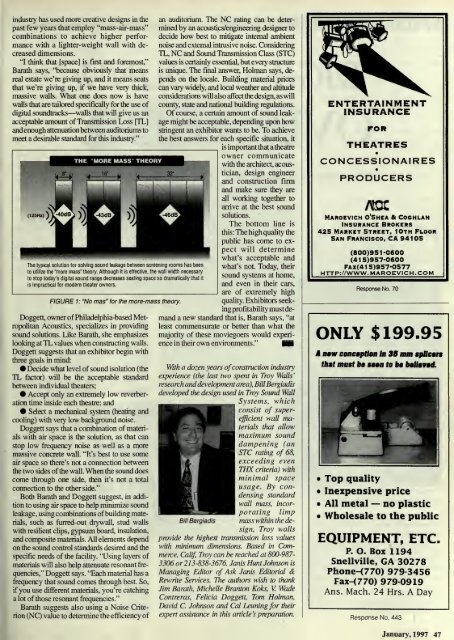Create successful ePaper yourself
Turn your PDF publications into a flip-book with our unique Google optimized e-Paper software.
industry has used more creative designs in the<br />
past few years that employ "mass-air-mass"<br />
combinations to achieve higher performance<br />
with a Hghter-weight wall with decreased<br />
dimensions.<br />
"I think that [space] is first and foremost,"<br />
Barath says, "because obviously that means<br />
real estate we're giving up, and it means seats<br />
that we're giving up, if we have very thick,<br />
massive walls. What one does now is have<br />
walls that are tailored specifically for the use of<br />
digital soundtracks—walls that will give us an<br />
acceptable amount of Transmission Loss [TL]<br />
and enough attenuation between auditoriums to<br />
meet a desirable standard for this industry."<br />
The typical solution for solving sound lealage between screening rooms has been<br />
to utilize tlie "more mass' theory. Although it is effective, the wall width necessary<br />
to stop today's digital sound range decreases seating space so dramatically that it<br />
is impractical for modern theater owners.<br />
FIGURE 1: "No mas" for the more-mass theory.<br />
Doggett, owner of Philadelphia-based MetropoUtan<br />
Acoustics, specializes in providing<br />
sound solutions. Like Baratii, she emphasizes<br />
looking at TL values when constructing walls.<br />
Doggett suggests that an exhibitor begin with<br />
three goals in mind:<br />
• Decide what level of sound isolation (the<br />
TL factor) will be the acceptable standard<br />
between individual theaters;<br />
• Accept only an extremely low reverberation<br />
time inside each theatre; and<br />
• Select a mechanical system (heating and<br />
cooUng) with very low background noise.<br />
Doggett says that a combination of materials<br />
with air space is the solution, as that can<br />
stop low frequency noise as weU as a more<br />
massive concrete wall. "It's best to use some<br />
air space so there's not a connection between<br />
the two sides of die wall. When the sound does<br />
come through one side, then it's not a total<br />
connection to the other side."<br />
Both Barath and Doggett suggest, in addition<br />
to using air space to help minimize sound<br />
leakage, using combinations ofbuilding materials,<br />
such as furred-out drywall, stud walls<br />
with resihent clips, gypsum board, insulation,<br />
and composite materials. All elements depend<br />
on the sound control standards desired and the<br />
specific needs of the facility. "Using layers of<br />
materials will also help attenuate resonant frequencies,"<br />
Doggett says. "Each material has a<br />
frequency that sound comes through best. So,<br />
if you use different materials, you're catching<br />
a lot of those resonant frequencies."<br />
Barath suggests also using a Noise Criterion<br />
(NC) value to determine the efficiency of<br />
an auditorium. The NC rating can be determined<br />
by an acoustics/engineering designer to<br />
decide how best to mitigate internal ambient<br />
noise and external intrusive noise. Considering<br />
TL, NC and Sound Transmission Class (STC)<br />
values is certainly essential, but every structure<br />
is unique. The final answer, Holman says, depends<br />
on the locale. Building material prices<br />
can vary widely, and local weather and altitude<br />
considerations will also affect the design, as will<br />
county, state and national building regulations.<br />
Of course, a certain amount of sound leakage<br />
might be acceptable, depending upon how<br />
stringent an exhibitor wants to be. To achieve<br />
the best answers for each specific situation, it<br />
is important that a theatre<br />
owner communicate<br />
with the architect, acoustician,<br />
design engineer<br />
and construction firm<br />
and make sure they are<br />
all woridng together to<br />
airive at the best sound<br />
solutions.<br />
The bottom line is<br />
this : The high quaUty the<br />
pubhc has come to expect<br />
will determine<br />
what's acceptable and<br />
what's not. Today, their<br />
sound systems at home,<br />
and even in their cars,<br />
are<br />
of extremely high<br />
quaUty. Exhibitors seek-<br />
ingprofitabilitymustde-<br />
mand a new standard that is, Barath says, "at<br />
least commensurate or better than what the<br />
majority of these moviegoers would experience<br />
in their own environments."<br />
Hi<br />
With a dozen years ofconstruction industry<br />
experience (the last two spent in Troy Walls'<br />
research and de\'elopment area), Bill Bergiadis<br />
developed the design used in Troy Sound Wall<br />
Systems, which<br />
Bill Bergiadis<br />
consist of superefficient<br />
wall materials<br />
that allow<br />
maximum sound<br />
dampening (an<br />
STC rating of 68,<br />
exceeding even<br />
THX criteria) with<br />
minimal space<br />
usage. By condensing<br />
standard<br />
wall mass, incorporating<br />
limp<br />
mass within the design,<br />
Troy walls<br />
provide the highest transmission loss values<br />
with minimum dimensions. Based in Commerce,<br />
Calif, Troy can be reached at 800-987-<br />
3306 or 213-838-3676 Janis Hunt Johnson is<br />
Managing Editor of Ask Janis Editorial &<br />
Rewrite Services. The authors wish to thank<br />
Jim Barath, Michelle Branton Koks, V. Wade<br />
Contreras, Felicia Doggett, Tom Holman,<br />
David C. Johnson and Cal Leaning for their<br />
expert assistance in this article's preparation.<br />
ENTERTAINMENT<br />
INSURANCE<br />
FOR<br />
THEATRES<br />
CONCESSIONAIRES<br />
PRODUCERS<br />
Ao:<br />
MAROEVICH O'SHEA a COCHLAN<br />
Insurance Brokers<br />
425 Market Street, 10th Floor<br />
San Francisco, CA 94105<br />
(800)951-0600<br />
(415)957-0600<br />
Fax(4 15)957-0577<br />
http://www.maroevich.com<br />
Response No. 70<br />
ONLY $199.95<br />
M OBw concBptoa la SB mm apOcm<br />
that must ba t»»u to b» MfaradL<br />
• Top quality<br />
• Inexpensive price<br />
• All metal — no plastic<br />
• Wholesale to the public<br />
EQUIPMENT, ETC.<br />
p. O. Box 1194<br />
Snellville, GA 30278<br />
Phone-(770) 979-3456<br />
Fax-

















